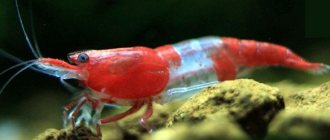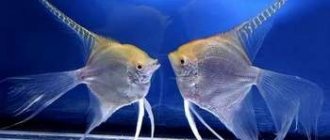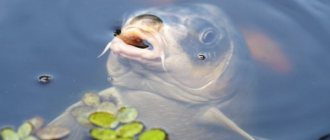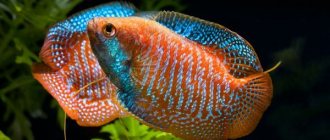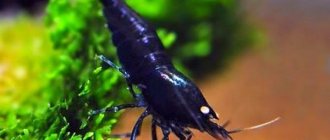The family of Poeciliidae or Gambusia fish is very diverse. It has about 20 genera and 140 species. Fish of this family have earned popularity among aquarists due to their variety of colors, unpretentiousness in choosing food and ease of maintenance.
They reproduce well in captivity. Different species of poeciliids can interbreed with each other, which allows for their selection. New forms bred by aquarists differ in size, shape and color of fins. The most famous were: Swordtails, Guppies, Platypecilia, Girardinus and Aplocheilichthys Norman.
Norman's blue-eyed photo
Aplocheilichthys or Norman's Blue-eye is a peaceful schooling fish, unpretentious in breeding and keeping. As a rule, Bluegills are silver in color with a pale blue or light green tint. They got their name from the bright blue color of the upper part of the iris. Adult fish have an elongated body, reaching 3-4 cm in length. The dorsal fin is located behind, the remaining fins are undeveloped.
Table of basic parameters of maintenance, care and nutrition:
| What should be the volume of the aquarium for Blue-Eyes Norman? | from 50 liters for a flock of 10 individuals |
| What should be the temperature in the aquarium for Norman's Blue Eyes? | from +22-25 °C |
| What pH should be in the aquarium? | from 6-7 pH |
| What should be the hardness of the water in the aquarium? | from 8-12° dH |
| What should be the substrate for an aquarium? | black primer with granules from 3-4 mm |
| What kind of lighting should be in the aquarium? | moderate |
| What should be the movement of water in the aquarium? | moderate |
| Maximum fish size | 3-4 cm in length |
| What does aquarium fish eat? | dry mixtures (flakes, granules). For variety: daphnia, coretra, tubifex, bloodworm, etc. (both live and frozen will do) |
| Type of aquarium fish | peaceful |
| Who is compatible with in an aquarium? | get along with other non-aggressive fish species of similar size; similar-sized shrimp and crustaceans |
| Lifespan | from 3-4 years |
Norman's Blueeye natural habitat
The bluegill inhabits shallow streams and rivers of Western and Central Africa along the subequatorial climate zone. It was first caught in Northern Nigeria and named after the English ichthyologist John Norman.
Habitat and contents
Gertrude's pseudomugil lives in slow-flowing and quiet rivers with dark water. Its homeland is considered to be Australia, Indonesia and Papua New Guinea. Blue-eyes have a light body with a graceful pattern, which has a slightly elongated shape. There are small black dots on the anal, dorsal fin and tail.
By the way, it is by the fins that you can easily determine the sex of the fish. Thus, in adult males, the unpaired fins are larger than in females, and the pectoral fins are raised upward and decorated with a yellow stripe. The male also has a slimmer body and more elongated fins.
The maximum size of this species is approximately 4 cm, so they can be kept in small aquariums. But it’s best to buy them several at a time , from about 6 to 15, depending on the volume of the aquarium, since in nature they swim in small flocks.
Don't forget to prepare your habitat
In order to create conditions for Gertrude as close as possible to her habitat, mosses, driftwood and long-trunked plants should be added to the aquarium. Fish love diffused light, so it is advisable to purchase floating algae for them. But at the same time, they should have enough free space to swim.
For a comfortable existence, the water temperature in the aquarium should not fall below 23 degrees. It is advisable to change the water at least once a week, and to maintain its cleanliness, you should install a filter.
In this video you will learn more about this fish:
Norman's blue-eye maintenance and care
Despite the miniature size of the fish, its long-term maintenance requires aquariums with a volume of 50 liters or more. Blue-eyes live in a flock of 6-10 individuals or more (the more, the better). The flock is mobile, especially during breeding. This explains the large size of their home.
The interior of the aquarium should provide an open space for swimming with shelters in the form of grottoes, curved branches and thickets. Floating plants are also necessary because... they create shade and prevent fish from jumping out of the tank.
To maintain biological balance, it is necessary to regularly change the water, remove waste and monitor the operation of the cleaning system installed in the aquarium. Due to the fact that Blueeyes do not like currents, the filter should be chosen so that it does not cause strong water movement.
Breeding
At the age of one year, Norman's Aplocheilichthys reaches sexual maturity. For spawning, you can plant a couple of fish, or you can leave them for spawning in a common aquarium. If you decide to place blue eyes in a separate aquarium, then it should have a capacity of 50 liters with aeration and active filtration. The bottom is planted with small-leaved plants without soil. Before spawning, the female and male fish are fed generously.
The female lays eggs on the green leaves of living plants; after the end of spawning, the spawners are removed. The incubation period lasts up to 15 days. A novice aquarist should keep in mind that fry are sensitive to aquarium cleanliness and changes in water parameters. Intense lighting promotes rapid growth of fish. Starter food: Cyclops, live dust and Artemia nauplii. The growth of blue-eye fry is rapid.
What to feed Norman's Blue Eyes
As mentioned above, Blue Eyes are unpretentious eaters. The main thing is that it contains more protein necessary to maintain vital activity. The basis of the daily menu is dry mixtures (flakes, granules). For variety, you should give daphnia, coretra, tubifex, bloodworms, etc. Both live and frozen food are suitable. It is recommended to feed 1-2 times a day. The remaining food that falls to the bottom is not eaten by the fish.
Norman's blueeye compatibility with other fish and shrimp
Blueeyes are very peaceful fish. There are never any conflicts within the pack. Aplocheilichthys get along well with other types of fish of a similar size: Tetras, Neons, Danios, Guppies, Swordtails, Plaecilias, Mollies, rainbow fish and others of a similar size, also with shrimps and crustaceans. Particularly good relations develop with close relatives, the Neon Lamp Eyes. But we must not forget that proximity to large and aggressive fish can end disastrously for Blueeyes.
Norman's blue-eye breeding in a community aquarium
Aplocheilichthys are easy to breed. The main thing is the correct selection of producers who quickly get used to a new place and retain their reproductive instincts. There are beautiful and healthy-looking fish, but they are completely unwilling to bear offspring. You shouldn’t waste time on these, but quickly find a replacement for them.
Unlike most members of the poeciliaceae or gambusiaceae, Aplocheilichthys are not viviparous. They spawn even in a community aquarium among small-leaved thickets. But the survival rate of fry can be very low if they are not placed in a separate container in time. Usually 1 male and 2 females are transplanted into the spawning tank. This could be a mesh fish tank attached to a common aquarium. Thus, the required oxygen regime and stable biofiltration are ensured.
A favorable environment for spawning will be clean water with a hardness of 8-12° dH, with a temperature of +22-25° C and 6-7 pH. The fish spawn every day, taking short breaks. Every day the female lays an average of 2 large transparent eggs. They attach to aquatic plants with thin sticky threads. To prevent hungry fish from eating future offspring, you should catch eggs along with plant branches every 2-3 days and place them in a hatchery.
The incubation period is up to 15 days. The fry, 3-5 mm long, appear fully formed, but slow. Therefore, they are constantly located near the water surface. At first, they feed on microscopic crustaceans, such as Artemia nauplii. Ciliates and rotifers are also suitable.
Growing up, the fry become more active and descend into the depths of the aquarium.
Reproduction
Poropanchax normani reach sexual maturity after an average of one year of life. Spawning can even be carried out in a community aquarium, but the probability of survival of the offspring is too low. Therefore, it is better to use a spawning aquarium for breeding this species.
An aquarium with a volume of 50 liters is used as a spawning tank, in which good aeration is organized and a powerful filter is installed. It is recommended to place aquatic plants with small leaves at the bottom of the container, even without soil. The following water parameters must be maintained in the aquarium:
- temperature - 24ºС;
- hardness - 10º;
- acid-base balance - 6.5-7.0.
Hard water with an alkaline reaction is detrimental to fry. There is a risk of fungus that prevents the normal development of young eggs.
When a pair of parents suitable for breeding is selected, they are placed in different aquariums and actively fed with protein food for a week.
In the spawning aquarium in the morning, the female lays eggs on the leaves of plants. When the male fertilizes the eggs, the parents are removed from the spawning tank.
The incubation period averages two weeks. Artemia nauplii, live dust or cyclops are used to feed young animals.
Over time, you can switch to special food for fry.
Norman's blue-eye female and male how to distinguish
It is easiest to determine sex in young individuals. If you look through the light, you can see the yellow color of the side zones of the male's tail. In adult fish, gender differences are not so noticeable.
Males are slightly larger than females, but this is not the main feature. The dorsal and caudal fins have elongated and pointed tips and become more delicate and transparent as they mature. Their color varies from bright yellow to orange with a black mesh or stripe towards the beginning. The color of the tail is similar to the fins. Males also have a hint of blue on their sides and the same stripes or dots on their tail.
Aplocheilichthys (Poropanchax) normani
Aplocheilichthys Norman, male
Norman's Aplocheilichthys
Russian name: Aplocheilichthys Normana.
Latin name: Aplocheilichthys normani; recently, according to some resources (including Fishbase), the name Poropanchax normani (Ahl, 1928) has been adopted . However, due to the fact that the wide mass of aquarists is not aware of the renaming, and this species goes on sale under the same name as before, here we give a new option as an additional one.
Trade names: Norman's lampeye, Lampeye killifish, Norman's aplocheilichthys, Norman's blue-eye, Norman's blue-eye.
Family: Poeciliidae.
Homeland: Africa, Niger River basin. Populations from the White Nile are also known. The species inhabits small rivers, streams, irrigation canals, swamps and does not like too fast flows.
Length of an adult fish: up to 4 cm, but usually smaller, from 3 to 3.5 cm.
Sexual differences: the female is about the same size or slightly smaller than the male, but when determining the sex of fish it is better to rely not on this characteristic, but on the color and shape of the dorsal and anal fins. In the male they are better developed, have slightly elongated and pointed ends, and with age they acquire a delicate and transparent, quite attractive color: various shades of yellow (from lemon to golden orange), usually with a black mesh or striped pattern closer to the base, but sometimes and without it. The tail has the same color. The species is generally quite variable; the male may also have a bluish sheen on his side and stripes or specks of the same color on his tail. There are also references to morphs with blue, red and purple tinted fins, however, due to the pronounced confusion of closely related species and the complete absence of such fish for sale and even in photos on the Internet, we will consider this data, at a minimum, to require verification.
In young and still poorly defined individuals, the easiest way to accurately notice gender differences is by examining the fish up to the light. The first thing that appears in males is not a change in the shape of the fins, but a yellow coloration of the lateral zones of the tail.
Requirements for water temperature: Norman's aplocheilichthys prefer not too warm water - +22...+26° C.
Requirements for chemical parameters of water: pH 6.5 - 7.2, GH 10-20. Does not require salting.
Minimum aquarium size: from 10 l.
Life expectancy: up to 4 years.
Intraspecific and interspecific compatibility: the fish are small and absolutely peaceful, they will never offend anyone. A distinctly schooling species: for successful keeping it is better to purchase at least 7-10 fish; in other cases, baby apocheilichthys will experience stress and, most likely, will not fully display their delicate beauty and will be more susceptible to disease. They can also look good in a display container, but this is far from the only possible option. They behave modestly in a common aquarium, one might even say that they are shy. Therefore, when selecting that are compatible with them, you need to take into account not only the water parameters and other required conditions, but also the nature of your future neighbors: you cannot plant any aggressive and clingy fish with “Normans”. They go well with many bottom-dwelling fish - primarily small and non-aggressive ones.
It is stress that weakens their health in the first place, and this point must always be kept in mind.
Feeding: Norman's apocheilichthys are quite unpretentious in their choice of food, but you need to remember that their mouth is very small, so the food items, be it pieces of dry food or small crustaceans, must be small, otherwise the fish may remain hungry. This species cannot be called slow, but too fast fish like zebrafish can leave a school of Aplocheilichthys to pick up the crumbs left after their meal. The species is animal-eating. They take food mainly from the water column, rarely from the bottom, so it is better to choose for them types of food that would float for some time in the water column or on the surface and would not immediately sink. Fish will undoubtedly appreciate feeding with fruit flies, live cyclops, brine shrimp or small daphnia.
Our experience of keeping Norman's Aplocheilichthys in an aquarium. Despite their modest outfit, you can’t help but pay attention to these fish because of their delightful bright blue eyes, which flicker with luminous sparkles even in the thick shade of plants, where a flock of these kids likes to swim. An excellent option for residents of a nano-aquarium, however, even in a larger volume - they will not get lost. It’s a pity that so far not so many Norman’s Aplocheilichthys go on sale; this fish really deserves much more popularity than it currently has. But there are reasons for this: she is quite tender and does not tolerate stress in general and long-term transportation in particular. Hence the problems associated with large waste in almost every incoming batch. Be prepared for the fact that, ideally, you will have to take some fish in reserve, even if they visually seem healthy. The first symptom of trouble is the presence of cloudy areas of the body (in the light). Cloudiness can spread over its entire area. Even if it is small, refrain from purchasing: very rarely fish that have reached this state return to normal. They usually die within 2-3 days. “Burning”, destruction of fins and difficulty breathing also indicate that the fish were exposed to ammonia on the way and/or in a commercial aquarium, which, naturally, has a serious impact on their health.
Weakened fish, even when placed in stable and calm conditions, can suffer for a month or a month and a half from the troubles they have endured and become victims of spontaneously occurring bacterial diseases - both skin and interstitial. In our opinion, it is not worth considering the aquarium “infectious”: if the disease does not resemble the acutely infectious classic Columnaria and other “Asian gifts”, then it is a consequence of a violation of the immunity of this particular individual. We have not encountered any cases where muscle clouding or a white coating on the body of aplocheilichthys was “caught” by some other fish, even if the carriers of the disease themselves quickly died from it right in the common aquarium.
For the reasons described above, the fish should be placed in a well- maintained aquarium with stable conditions. It is better if the soil there is dark, and in some places the plants form thickets in which mobile apocheilichthys like to lurk. According to our observations, they do not like too fresh water; for this particular species, 15-20% changes per week are quite enough, just so that the biofiltration in the aquarium works powerfully and without failures. But it is better not to allow water to become oversaturated with organic matter. Plants are not damaged.
Having finally adapted to a new place, fish that have successfully survived the relocation acquire much greater stability and, in general, can be considered quite unpretentious and rarely get sick. The words that Norman's aplocheilichthys are very tender relate exclusively to the moments of transportation. An established flock will please the eye for quite a long time, and with minimal effort on the part of the aquarist, he himself will be able to replenish it with juveniles of his own breeding.
Breeding Norman's Aplocheilichthys. This species is not difficult to breed. The main thing is to select breeders who have successfully adapted to the aquarium and have not lost their mating instincts. Occasionally there are individuals that are quite healthy and beautiful to look at, but flatly refuse to reproduce. It’s better not to bother with these any further and simply replace them in the spawning tank with others.
In principle, usually even a spawning tank is not required. Norman's Aplocheilichthys belongs to the group of non-seasonal killifish, so its eggs are incubated, although for a long time, but not for months, as in other species of egg-laying carp-toothed fish. Fry can also appear in a general aquarium, and if there are not very many fish there and there are dense thickets of plants reaching the surface, several fry are almost guaranteed to grow up on the “pasture” themselves.
However, we still placed three fish - a male and two females - in a mesh cage suspended directly in the aquarium. This ensured an optimal oxygen regime and stable biofiltration, and the size of the producers is so small that even with this small “cube” they do not feel constrained and actively play on the substrate, which is best used as Java moss or other small-leaved plants. It is better to confuse them a little and press them to the bottom of the depositor with a pebble. In a female ready for spawning, the abdomen becomes rounded, sometimes a translucent mass of peach-colored caviar is clearly visible through it. If the fish is thin, then there is no point in planting it for spawning. It’s better to keep it separately and fatten it up for a week or two.
Eggs are laid almost every day, sometimes there are short pauses, but usually each female produces 1-3 eggs per day. The eggs are large, transparent, suspended from the plants on sticky threads. On many resources they write that the fish themselves can look for it or the swimming fry and eat it, but we got the impression that they only do this out of hunger - this has never happened to us. However, it is better to sort through the substrate at least once every 2-3 days and pull out the eggs from there along with fragments of twigs, placing them in another aquarium, which can be easily made from a plastic bottle . The eggs of Norman's apocheilichthys are hard and very tenacious; with a certain amount of accuracy, you can safely sort through a lump of moss in the air directly with your hands, selecting new eggs by touch.
The incubation period depends on the temperature, usually 8-12 days pass before the larvae hatch. At first, the caviar is transparent and very difficult to see, then it becomes almost black (the embryo is visible). The babies, about 3-4 mm long, emerge fully formed. They are immediately able to feed and already have a caudal fin. The fry are slow and stay strictly near the surface film of water. Ciliates, rotifers, and dust-like feeds are suitable as starter food (we used Sera Micron very well). Naturally, if there are live ones, you shouldn’t overuse dry ones - the young will be healthier and will grow better. As they grow older, young fish become able to move lower into the water column. The fry do not exhibit cannibalism, even if they differ in size.
Puberty occurs at the age of 4-6 months.
Tasha. Photo by Tasha. Sudogda, September 09, 2012
Norman's blue-eye disease
There are a lot of diseases that affect aquarium inhabitants. Their main reasons:
- neglected condition of the aquarium (stagnant water, large amounts of uneaten food and waste products);
- unsuitable water composition (too soft or too acidic);
- poor arrangement of the aquarium (lack of shelters, insufficient container sizes, etc.);
- incompatibility of fish breeds;
- poorly selected diet, poor quality food, lack of nutrition.
For Blueeyes, the main threat is live food, which often carries protozoan parasites that cause diseases that are difficult to diagnose and treat. The situation is complicated by an additional bacterial or fungal infection. For treatment, drugs with a broad spectrum of action are used, usually containing phenoxyethanol. It suppresses both fungus and symptoms of bacterial infection.
The most common infectious disease of the entire poeciliaceae family is a form of mycobacteriosis. Characteristic signs of “fish tuberculosis”: exhaustion, arched back, sunken eyes, protruding skeletal bones. The fish stop feeding and stay separate from the school. Today the disease is incurable. Therefore, suspicious individuals must be destroyed as quickly as possible and aquarium equipment must be disinfected. All newly acquired aquarium inhabitants should be placed in another container. The quarantine period is 3 months.
If favorable conditions are created and maintained in the aquarium, then the likelihood of disease is extremely low. The immune system of healthy Aplocheilichthys quickly copes with most parasitic, fungal and viral diseases.
Compatibility with other species and nutrition
Pseudomugil gertrudae are peaceful fish, so it is best to keep them with species similar in size and behavior. The fish themselves are quite shy, and they feel more confident if they swim in large schools. In small aquariums it is better to keep them alone or with snails. If the volume allows, then freshwater shrimp or other nano-fish can be added to the spotted blue-eyes. They get along well with the following species:
- Iriaterina Werner;
- Tetra Amanda;
- Rasbora Espey;
- pecilobricones;
- Formosa.
The life expectancy of this species is short; in the natural environment they live only one season. In aquariums, under favorable conditions, this period is extended to 18 months. To keep your fish active and healthy, they need to have a variety of foods in their diet.
Can be fed with live food
In nature, this species mainly feeds on invertebrates and phytoplankton. The following foods are suitable for aquarium fish:
- live (daphnia, small bloodworms, moina, microworms);
- dry (granules, plates, flakes);
- frozen.
When feeding Gertrude the fish, it is important to ensure that her diet is balanced and varied. It is better not to buy dry food for her in bulk and should store them in tightly closed containers.
Live food stimulates them to reproduce




